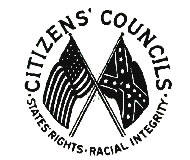Publishing and broadcasting
Unlike the secretive Ku Klux Klan but working in unison, the White Citizens Council met openly. It was seen superficially as "pursuing the agenda of the Klan with the demeanor of the Rotary Club". [17] From October 1954, the council published a newsletter, The Citizens' Council, which evolved into a magazine in October 1961 and continued to be published until 1989 as The Citizen. [9]
From 1957 to 1966, the Citizens' Council had a broadcast program, The Citizens Forum, where they exposed their doctrine of segregation. First broadcast by the WLBT as a television program, it switched to a radio format and was broadcast from Washington, DC, using congressional studios with the help of people like James Eastland, a U.S. senator from Mississippi. Various personalities such as Eastland or John Bell Williams were interviewed there. From 1966, they did emissions from African countries such as Rhodesia, interviewing Ian Smith. [18] [19]
Among its other activities, throughout the last half of the 1950s, the White Citizens' Councils produced racist children's books, for instance, teaching that heaven (in the Christian conception) is segregated. [20]
Voter suppression
Citizens' Councils conducted voter purges to remove Black voters from election rolls. [24]
Before the practice was found illegal in a federal court case of 1963, the Council pushed a public challenge law allowing two voters to challenge another voter to see if he was lawfully registered, a provision they used to purge the rolls of Black voters. In one parish, Bienville Parish, 95% of Black voters were purged. [24] Similarly, the Council distributed such pamphlets as "Voter Qualification Laws in Louisiana: The Key to Victory in the Segregation Struggle" to white registrars and required them to participate in mandatory seminars about preventing Black registration and purging Black voters. [25]
Violence and economic harassment
Although the White Citizens Councils publicly eschewed the use of violence, [2] they condoned the harsh economic and political tactics which were used against registered voters and activists. The members of the White Citizens Councils collaborated in order to threaten jobs, causing people to be fired or evicted from rental homes; they boycotted businesses, ensured that activists could not get loans, among other tactics. [26] As historian Charles Payne notes, "Despite the official disclaimers, violence often followed in the wake of Council intimidation campaigns." [17] Occasionally some Councils directly incited violence, such as lynchings, shootings, rapes and arson, as did Leander Perez during the New Orleans school desegregation crisis. In some cases, Council members were directly involved in acts of violence. Entertainer Nat King Cole was assaulted in Birmingham, Alabama while he was on tour. Byron De La Beckwith, a KKK and Council member, murdered Medgar Evers, the head of the NAACP in Mississippi.
For instance, in Montgomery, Alabama, during the Montgomery bus boycott, at which Senator James Eastland "ranted against the NAACP" [27] at a large openly held Council meeting in the Garrett Coliseum, a mimeographed flyer publicly espousing extreme racial White Citizens Council and Ku Klux Klan views was distributed. Its rhetoric was a parody of the Declaration of Independence:
When in the course of human events, it becomes necessary to abolish the Negro race, proper methods should be used. Among these are guns, bows and arrows, sling shots and knives.
We hold these truths to be self-evident that all whites are created equal with certain rights; among these are life, liberty and the pursuit of dead niggers. [27] [28]
The Citizens' Councils used economic tactics against African Americans who they believed were supportive of desegregation and voting rights, as well as African Americans who were members of the NAACP, and African Americans who they suspected of being activists. The tactics included "calling in" the mortgages of black citizens, denying loans and business credit, pressing employers to fire certain people, and boycotting black-owned businesses. [29] In some cities, the Councils published lists of names of NAACP supporters and signers of anti-segregation petitions in local newspapers in order to encourage economic retaliation. [30] For instance, in Yazoo City, Mississippi in 1955, the Citizens' Council published in the local paper the names of 53 signers of a petition for school integration. Soon afterward, the petitioners lost their jobs and had their credit cut off. [31] As Charles Payne puts it, the Councils operated by "unleashing a wave of economic reprisals against anyone, Black or white, seen as a threat to the status quo". [17] Their targets included black professionals such as teachers, as well as farmers, high school and college students, shop owners, and housewives.
Medgar Evers' first work for the NAACP on a national level involved interviewing Mississippians who had been intimidated by the White Citizens' Councils and preparing affidavits for use as evidence against the Councils if necessary. [32] Evers was assassinated in 1963 by Byron De La Beckwith, a member of the White Citizens' Council and the Ku Klux Klan. [33] The Citizens' Council paid Beckwith's legal expenses in his two trials in 1964, which both resulted in hung juries. [34] In 1994, Beckwith was tried by the state of Mississippi based on new evidence, in part revealed by a lengthy investigation by the Jackson Clarion Ledger; he was convicted of first-degree murder and sentenced to life in prison. [35]



